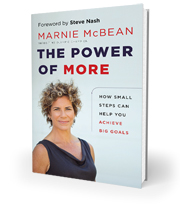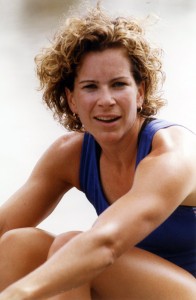
About the Book
The Power of More shows readers how to accomplish their goals, big or small. Whether you are a novice runner who wants to run a 10k race, a sales rep who wants to increase market share, or an elite athlete trying to conquer the world stage, you can achieve your ambition by believing in the importance of doing a little bit more.
With humour and insight, three-time Olympic champion Marnie McBean discusses the importance of breaking big goals down into manageable bits of “more.” For example, when she decided to run to the top of the CN Tower in Toronto for a fundraising event, she focused not on running all 1,776 steps but on running up one step and then one more step. The Power of More is not about concentrating on the more you can get but the more that you can do. Even when you think you’re done, you aren’t—chances are you have a bit more to give.
McBean discusses the importance of setting goals, the role of communication and teamwork, and the need for motivation, commitment, and accountability. Finally, while she encourages people to strive to be perfect she punctures the myth that we should expect to be perfect and stresses that both confidence and success are the result of preparation.
30 May 2012
A Recipe for Success
Olympic gold medallist Marnie McBean outlines a strategy for setting and achieving goals that can be applied to business – or any aspect of life
By George Hartman | June 2012 for Investment Executive
How often have you set a goal and achieved it? Chances are this has happened to you a number of times. Feels good, right? Now, how often have you set a goal that others have said was too high for you – beyond your grasp and capabilities – and achieved that one? Not as often, I bet. But how good would that feel?
Marnie McBean, three-time Olympic gold medallist and winner of numerous other championships, knows all about setting audacious goals and, more important, what it takes to defy the limits that are imposed on us, either by ourselves or by others.
In The Power of More: How Small Steps Can Help You Achieve Big Goals, McBean describes her journey to world dominance in the sport of rowing – the dreams, the challenges, the pinnacles of success and the depths of disappointment. Part autobiography and part confessional, the book also is invaluably instructional and inspirational for anyone who has set their sights on personal accomplishment in sports, business or life.
As the title suggests, the book’s theme is about breaking large goals into smaller pieces and doing “just a little bit more” when the task seems too difficult. That is, pushing yourself one notch closer to your goal, whether it is connecting with that elusive new prospective client, perfecting an important presentation, completing a tedious project, climbing the CN Tower or running your first 10-kilometre race. (Which, coincidently, I did one week after reading this book, with McBean’s words – “Just one more step” – carrying me to setting a personal-best time.)
McBean follows a logical path from goal-setting through preparation, teamwork, commitment and accountability to the actual “test” that determines success. Here are just a few of this book’s many memorable insights that stand out for me.
- Grains of rice in a cup. This metaphor runs through many parts of the book, beginning early in the process – that is, in our preparation for a task. McBean likens preparing for a goal to filling a cup with grains of rice, with each grain representing some time and effort that we contribute toward that goal. The contributions could be in the areas of physical conditioning, mental awareness, emotional well-being or health. The more grains of rice we add to our cup, the greater the likelihood of meeting our objective.
It’s also important to know there will be times when we take grains out of our cup through failure to maintain a development plan, lack of commitment or reduced focus.
- Cable vs chain. In the chapter on teamwork, McBean notes that great teams come together not because the individual members are similar to each other but because they complement each other’s strengths and have shared goals. Almost inevitably, however, as we become more comfortable in our own role within the team structure, we begin to look more critically at the strengths and weaknesses of our teammates. If we allow ourselves to focus too much on the perceived weaknesses of others, we begin to think of them as “weak links in the chain” and anticipate failure if they falter in any way.
At times like this, it is important to think of the team working as a cable rather than as a chain. In a cable, every strand does not have to be perfect. Winding all the strands together is what gives the cable strength and, even if one strand breaks completely, the cable can still withstand great strain.
- Can I? Will I? In the chapter that deals with the test that proves whether we will achieve our goal, McBean suggests we will be confronted regularly by moments when we question our ability and our commitment. She describes three possible reactions to these moments of challenge: we quit; we close our eyes and pray that things work out; or we attack the challenge with all the vigour, skill and intensity we have.
The first choice is the easiest to make and to justify. Perhaps, we argue, the goal was too big in the first place or circumstances beyond our control have made it more difficult to achieve. Whatever the rationale, we give ourselves permission to quit. And the more often we do that, the easier it becomes to quit again.
The second option is somewhat more difficult because it doesn’t allow us to let go of the goal – just our accountability for achieving it. In other words, we begin to rely on luck and fate to determine our success. The problem with this choice is, in the end, we are left wondering, “What if?”
The third choice is, of course, the most difficult. It means driving forward, breaking our self-imposed limits and giving more.
The Power of More is much more than a motivational story about a great athlete. It is an opportunity for all of us to look inside ourselves, decide what we want to achieve, big or small, and plot a path to get there. We may not aspire to be Olympic gold medallists; but that doesn’t preclude us becoming champions in our own lives. IE
The Power of More: How Small Steps Can Help You Achieve Big Goals
by Marnie McBean,
Greystone Books;
251 pages,
About Marnie

Marnie McBean is one of Canada’s most decorated Olympians, and an expert in turning potential into performance. As one of only two Canadians ever to win three Gold medals in the Summer Olympics, she is used to performing under pressure. Her 12 World and Olympic medals bear witness to this.
After a record-breaking rowing career, the Canadian Olympic Committee has hired her as a Specialist in Olympic Athlete Preparation and Mentoring. She has worked closely with the last 4 Olympic teams, including the very successful Vancouver 2010 Olympic Team and the recent London 2012 Olympic Team. She works with athletes to prepare them emotionally and psychologically, helping to transform their potential into reality. Her job, simply, is to ensure the highest performance possible.
At the London Olympics, her 8th Olympic Games, she worked in studio with Brian Williams as an analyst on CTV’s primetime Olympic program. A member of the Canadian Sports Hall of Fame and the Guinness Book of World Records, and a recipient of the Governor General’s Medal, McBean, concurrent to her Olympic career, also managed to finish a degree in Kinesiology from the University of Western Ontario. She is also actively involved in helping to promote the safety, health and activity of Canada’s youth as well as many sport and athlete development groups.
Source:
A Recipe for Success | Marnie McBean / The Power of More
LINK: http://marniemcbean.ca/a-recipe-for-success/
.............................................
A renowned motivational speaker and Olympic champion shares strategies for realizing your ambitions.
The Power of More shows readers how to accomplish their goals, big or small. Whether you are a novice runner who wants to run a 10k race, a sales rep who wants to increase market share, or an elite athlete trying to conquer the world stage, you can achieve your ambition by believing in the importance of doing a little bit more.
With humour and insight, three-time Olympic champion Marnie McBean discusses the importance of breaking big goals down into manageable bits of "more." For example, when she decided to run to the top of the CN Tower in Toronto for a fundraising event, she focused not on running all 1,776 steps but on running up one step and then one more. The Power of More is about concentrating not on the more you can get but the more that you can do. Even when you think you're done, you aren't -- chances are you have a bit more to give.
McBean discusses the importance of setting goals, the role of communication and teamwork, and the need for motivation, commitment, and accountability. Finally, while she encourages people to strive for perfection, she punctures the myth that we should expect to be perfect and stresses that both confidence and success are the result of preparation.
Source Amzon:
The Power of More shows readers how to accomplish their goals, big or small. Whether you are a novice runner who wants to run a 10k race, a sales rep who wants to increase market share, or an elite athlete trying to conquer the world stage, you can achieve your ambition by believing in the importance of doing a little bit more.
With humour and insight, three-time Olympic champion Marnie McBean discusses the importance of breaking big goals down into manageable bits of "more." For example, when she decided to run to the top of the CN Tower in Toronto for a fundraising event, she focused not on running all 1,776 steps but on running up one step and then one more. The Power of More is about concentrating not on the more you can get but the more that you can do. Even when you think you're done, you aren't -- chances are you have a bit more to give.
McBean discusses the importance of setting goals, the role of communication and teamwork, and the need for motivation, commitment, and accountability. Finally, while she encourages people to strive for perfection, she punctures the myth that we should expect to be perfect and stresses that both confidence and success are the result of preparation.
Review
"Marnie combines the lessons and parallels of the rowing world in such a way that makes it easy to apply them to any other challenge. It's obvious why she is both a world-class athlete and great athlete mentor and a businessperson all in one. I'm jealous!" (Sir Matthew Pinsent, four-time Olympic rowing champion 20120322)
"...many memorable insights that stand out...The Power of More is much more than a motivational story about a great athlete. It is an opportunity for all of us to look inside ourselves, decide what we want to achieve, big or small, and plot a path to get there. We may not aspire to be Olympic gold medalists; but that doesn't preclude us becoming champions in our own lives." (Investment Executive 20120529)
"A truly entertaining and inspiring read. I loved it!" (Hayley Wickenheiser, three-time Olympic ice hockey champion 20120322)
"Marnie's insight has changed the way I approach training, competition, and life. She has been a difference maker to me, and I consider her a part of our gold medal success." (Tessa Virtue, World and Olympic figure skating champion 20120322)
"McBean's book is crammed with such nuggets -- unique, often off-the-wall anecdotes and life lessons." (Neil Davidson Canadian Press 20120516)
"If anyone is entitled to be writing about achieving goals, it would be a three-time Olympic rowing champion with three gold and one bronze medal. In The Power of More, Marnie McBean translates her infectious energy into a book that is the equivalent of verbal Red Bull...Need a hand to hold? A big nudge? A cheerleading squad? Listen to McBean. Four Olympic medals are proof that her plan and idealistic thinking works." (Jules Torti Vancouver Sun 20120804)
"...many memorable insights that stand out...The Power of More is much more than a motivational story about a great athlete. It is an opportunity for all of us to look inside ourselves, decide what we want to achieve, big or small, and plot a path to get there. We may not aspire to be Olympic gold medalists; but that doesn't preclude us becoming champions in our own lives." (Investment Executive 20120529)
"A truly entertaining and inspiring read. I loved it!" (Hayley Wickenheiser, three-time Olympic ice hockey champion 20120322)
"Marnie's insight has changed the way I approach training, competition, and life. She has been a difference maker to me, and I consider her a part of our gold medal success." (Tessa Virtue, World and Olympic figure skating champion 20120322)
"McBean's book is crammed with such nuggets -- unique, often off-the-wall anecdotes and life lessons." (Neil Davidson Canadian Press 20120516)
"If anyone is entitled to be writing about achieving goals, it would be a three-time Olympic rowing champion with three gold and one bronze medal. In The Power of More, Marnie McBean translates her infectious energy into a book that is the equivalent of verbal Red Bull...Need a hand to hold? A big nudge? A cheerleading squad? Listen to McBean. Four Olympic medals are proof that her plan and idealistic thinking works." (Jules Torti Vancouver Sun 20120804)
About the Author
Steve Nash, OC, OBC is a Canadian professional basketball player who plays point guard for the Phoenix Suns. In 2001, Nash founded the Steve Nash Foundation, which aims to foster health in kids by funding projects that provide services to children affected by poverty, illness, abuse, or neglect, and create opportunity for education, play, and empowerment. It's efforts focus in both Phoenix, Arizona and Vancouver, British Columbia. In 2007, Nash received the Order of Canada in honour of his philanthropic efforts.
Marnie McBean holds three gold medals and a bronze medal from Olympic rowing competitions and is Canada's most successful Summer Olympic athlete. She is now a specialist in athlete preparation and mentoring with the Canadian Olympic Committee. She has a degree in Honors Kinesiology from the University of Western Ontario as well as three honorary doctorates. She is a member of Canada's Sport Hall of Fame and an ambassador for Right to Play and Plan Canada's "Because I am a Girl" initiative. She lives in Toronto.
Marnie McBean holds three gold medals and a bronze medal from Olympic rowing competitions and is Canada's most successful Summer Olympic athlete. She is now a specialist in athlete preparation and mentoring with the Canadian Olympic Committee. She has a degree in Honors Kinesiology from the University of Western Ontario as well as three honorary doctorates. She is a member of Canada's Sport Hall of Fame and an ambassador for Right to Play and Plan Canada's "Because I am a Girl" initiative. She lives in Toronto.
Source Amzon:





 Dean Ornish, MD
Dean Ornish, MD

